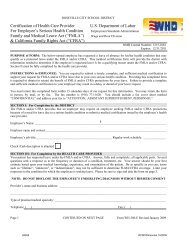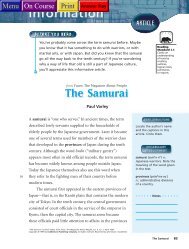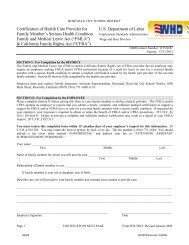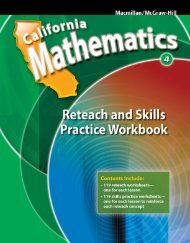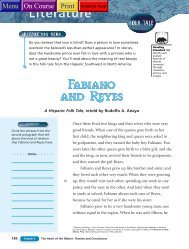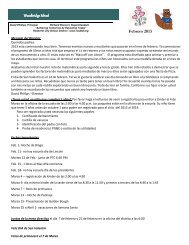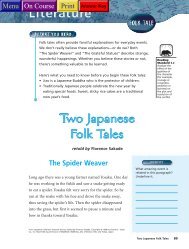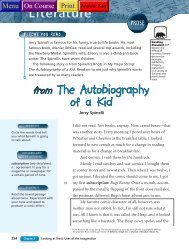Interactive Reading
Interactive Reading
Interactive Reading
Create successful ePaper yourself
Turn your PDF publications into a flip-book with our unique Google optimized e-Paper software.
In the early 1980s, Virginia Hamilton, who had alreadypublished many novels and biographies, decided to tryher hand at writing folk tales. In 1985, she publishedThe People Could Fly, a collection of African Americanfolk tales dating from the time of slavery. Hamilton went on to publishthree more collections of folk tales: In the Beginning: CreationStories from Around the World (1988); Her Stories, African AmericanFolktales, Fairy Tales, and True Tales (1995); and When Birds CouldTalk & Bats Could Sing (1996).Speaking of her four volumes of folk tales, Hamilton notes: “Noneof these stories was ever written for children. They were just told;so I redid them, brought them out of the musty old manuscriptswhere nobody ever saw them.” She often finds the stories in oldmanuscripts or out-of-print materials in libraries.Here’s what you might like to know before you begin these twoversions of “Little Red Riding-Hood”:• Like many folk tales, the story of Little Red Riding-Hood is foundin different cultures around the world. Each culture puts its ownunique spin on the story.• Virginia Hamilton uses dialect in her version of the folk taleto describe her characters and setting. Dialect is the way peoplein a certain region, or even in a certain age group, speak.When dialect appears in print, the words are often spelled andpronounced differently from the way they are in standard English.<strong>Reading</strong>Standard 3.1Identify theforms of fiction,and describethe majorcharacteristicsof each form.156 Chapter 4 Forms and Patterns: Stories and Explanations
The storyteller usesnonstandard English here.Underline the word in lines32–33 that would not befound in the dictionary.Write the standard Englishword that means the samething above it.• • • • • • Notes • • • • • •304050behind her. And there’s the wolf. He says, “Did you move?”in a gruff voice.Little Daughter says, “Oh, no, dear wolf, what occasionhave I to move?”“Well, sing that sweetest, goodest song again,” saysthe wolf.Little Daughter sang it:“Tray-bla, tray-bla, cum qua, kimo.”And the wolf is gone again.The child goes back some more, pit-a-pat, pit-a-pat,pit-a-pat, softly on tippy-toes toward the gate.But she soon hears very loud, PIT-A-PAT, PIT-A-PAT,comin behind her. And there is the great big wolf, and hesays to her, says, “I think you moved.”“Oh, no, dear wolf,” Little Daughter tells him, “whatoccasion have I to move?”So he says, “Sing that sweetest, goodest song again.”Little Daughter begins:“Tray-bla, tray-bla, tray-bla, cum qua, kimo.”The wolf is gone.But, PIT-A-PAT, PIT-A-PAT, PIT-A-PAT, cominon behind her. There’s the wolf. He says to her, says,“You moved.”She says, “Oh, no, dear wolf, what occasion have Ito move?”“Sing that sweetest, goodest song again,” says the big,bad wolf.She sang:“Tray bla-tray, tray bla-tray, tray-bla-cum qua, kimo.”The wolf is gone again.And she, Little Daughter, pit-a-pat, pit-a-pat, pit-apattinaway home. She is so close to the gate now. And this158 Chapter 4 Forms and Patterns: Stories and Explanations
60time she hears PIT-A-PAT, PIT-A-PAT, PIT-A-PAT cominon quick behind her.Little Daughter slips inside the gate. She shuts it—CRACK! PLICK!—right in that big, bad wolf’s face.She sweetest, goodest safe!Were you surprised by theending of this tale? Whyor why not?retold by Patricia Pierce10Once upon a time there was a little village girl, the prettiestever seen; her mother doted upon her, and so did hergrandmother. She, good woman, made for her a little redhood which suited her so well, that everyone called herLittle Red Riding-Hood.One day her mother, who had just made some cakes,said to her: “My dear, you shall go and see how yourgrandmother is, for I have heard she is ailing; take her thiscake and this little pot of butter. Go quickly, and don’t talkto strangers on the way.”Little Red Riding-Hood started off at once for hergrandmother’s cottage, which was in another village.While passing through a wood she walked slowly, oftenstopping to pick flowers. She looked back and saw a wolfapproaching, so she stopped and waited. The wolf, whowould very much liked to have eaten her, dared not,Circle the phrase “Once upona time.” What do you predictthe story will be like?Folk and fairy tales ofteninclude a warning to thehero or heroine. Underlinethe warning in paragraph 2.Do you predict it will beobeyed?“Little Red Riding-Hood” from The Larousse Book of Fairy Tales, compiled by Patricia Pierce. Copyright © 1985by Hamlyn, a division of Reed Elsevier. Reprinted by permission of the publisher.Little Red Riding-Hood 159
• • • • • • Notes • • • • • •“Pull the bobbin, andthe latch will go up!”In lines 20–23, what warningis Little Red Riding-Hoodforgetting?20because some woodcutters were nearby in the forest. Sohe said, “Good morning, Red Riding-Hood. Where areyou going?”The poor child, who did not know it was dangerousto talk to a wolf, answered, “I am going to see my grandmother,to take her a cake and a little pot of butter thatmy mother sends her.”160 Chapter 4 Forms and Patterns: Stories and Explanations
304050“Does she live a great way off?” said the wolf.“Oh, yes!” said Little Red Riding-Hood, “she livesbeyond the mill you see right down there in the first housein the village.”“Well,” said the wolf, “I shall go and see her too. I shalltake this road, and you take that one, and let us see whowill get there first!”The wolf set off at a gallop along the shortest road; butthe little girl took the longest way and amused herself bygathering nuts, running after butterflies, and pluckingdaisies and buttercups.The wolf soon reached her grandmother’s cottage; heknocked at the door—rap, rap.“Who’s there?”“ ’Tis your grand-daughter, Little Red Riding-Hood,”said the wolf in a shrill voice, “and I have brought you acake and a little pot of butter that my mother sends you.”The good old grandmother, who was ill in bed, calledout, “Pull the bobbin, and the latch will go up!”The wolf pulled the bobbin and the door opened. Heleaped on the old woman and gobbled her up in a minute;for he had had no dinner for three days past.Then he shut the door and rolled himself up in thegrandmother’s bed, to wait for Little Red Riding-Hood.In a while she came knocking at the door—rap, rap.“Who’s there?”Little Red Riding-Hood, who heard the gruff voice ofthe wolf, was frightened at first, but thinking that hergrandmother had a cold, answered, “ ’Tis your granddaughter,Little Red Riding-Hood, and I have brought youa cake and a little pot of butter that my mother sends you.”well (wel) inter.: here, wellis used as an interjection,a word that expressesemotion. Wow! is a commoninterjection.Well can also be a noun,meaning “hole in the earthfrom which comes water,gas, or oil.” Well can alsobe an adverb meaning “ingood health.”Pause at line 30. What doyou predict will happen next?Circle the word bobbin (line42), an old-fashioned term.Look at the illustration onpage 160. Find the bobbin,and write a definition.past (past) adj.: time that hasgone by.Don’t confuse past with theverb passed. Past means“time that has gone by.”Passed is the past tense ofpass, which means “go fromone place to another” or “gothrough a test successfully.”Little Red Riding-Hood 161
interest (in√trist) n.: concernor curiosity about something.Interest can also mean“money paid for the use ofmoney,” as in “The bankcharged 5 percent intereston the student loan.”This is one of the best-lovedfolk-tale passages in theworld. Read the boxedpassage aloud with a partneras if you were performingfor a roomful of children.See how scary you cansound.• • • • • • Notes • • • • • •607080Then the wolf called to her in as soft a voice as hecould, “Pull the bobbin, and the latch will go up.” Little RedRiding-Hood pulled the bobbin and the door opened.When the wolf saw her come in, he covered himself upwith the sheets, and said, “Put the cake and the little pot ofbutter on the chest, and come and lie down beside me.”Little Red Riding-Hood went over to the bed; she wassurprised to see how strange her grandmother looked inher nightcap. But she took off her cloak and hung it up,then went back and sat down by the bed. She looked at hergrandmother again with great interest.She said to her, “Oh, grandmamma, grandmamma,what great arms you have got!”“All the better to hug you with, my dear!”“Oh, grandmamma, grandmamma, what great legsyou have got!” she said.“All the better to run with, my dear!”“Oh grandmamma, grandmamma, what great ears youhave got!” said the little girl.“All the better to hear you with, my dear!”“Oh grandmamma, grandmamma, what great eyes youhave got!” she said, beginning to get frightened.“All the better to see you with, my dear!”“Oh, grandmamma, grandmamma, what great teethyou have got!” said Little Red Riding-Hood.“All the better to gobble you up!” said the wicked wolf,suddenly sitting up in the bed, drooling with hunger.Little Red Riding-Hood screamed with terror and leaptup from her chair. Then a shot from a gun was heard, andthe wicked wolf dropped back in the bed—dead.A woodcutter who was passing had heard the cries ofLittle Red Riding-Hood, popped his gun through the162 Chapter 4 Forms and Patterns: Stories and Explanations
90100110window, and shot the wolf in time to save her. The woodcutterrushed into the cottage and picked up Little RedRiding-Hood, who was trembling with fright. She was ableto tell the woodcutter, between her tears, that the wolf hadeaten up her grandmother. Quick as a wink, the woodcuttercut open the wolf’s stomach and rescued the old lady, whosoon recovered from her dreadful experience. She thankedthe woodcutter for his timely arrival, and for saving bothher and Little Red Riding-Hood. They both wavedgoodbye, when he left to go back to his work in the forest.The old lady hugged her dear little grand-daughter andasked if she might have a cup of tea, please.“Yes, of course,” said Little Red Riding-Hood. She putthe kettle on and put out the cake her mother had made ona pretty little plate. While she was waiting for the kettle toboil, she made her grandmother comfortable once more.All Little Red Riding-Hood really wanted to do was togo home to her mother, for she was still very frightened byall that had happened. So she kissed her grandmothergoodbye and ran all the way home. When she came to thecottage, she found her mother waiting for her at the door.The mother drew Little Red Riding-Hood in, andlistened to her story of all that had happened. She wasdelighted to have her little girl home safely again, andLittle Red Riding-Hood was so happy to be out of dangerthat she promised her mother never to be disobedientany more.In folk tales fantastic thingshappen, especially to savegood people. What are weasked to believe here?drew (drº) v.: pulledtoward.The word drew can havemore than one meaning,depending on its context.For example, it can mean“sketched.” What do youthink the mother was doingwhen she “drew Little RedRiding-Hood in"?Re-read the last line of thisstory. What lesson does LittleRed Riding-Hood (and all thechildren listening to this tale)learn?Little Red Riding-Hood 163
Forms of Fiction Make a list of at least four different folk-talecharacteristics used in these two versions of “Little Red Riding-Hood.” Give specific examples from each tale. Compare yourfolk-tale characteristics in class.Personal Word List You collected several words with multiplemeanings as you read these folk tales. Now, add the words toyour Personal Word List.Personal <strong>Reading</strong> Log Which version of the Little Red Riding-Hoodfolk tale did you enjoy more? Why? Write your reasons. You’ve justearned 3 points on the <strong>Reading</strong> Meter for completing these twofolk tales.Checklist for Standards Mastery Use the Checklist for StandardsMastery to see how far you have come in mastering the standards.164 Chapter 4 Forms and Patterns: Stories and Explanations
A Wolf and Little Daughter;Little Red Riding-Hood <strong>Interactive</strong> <strong>Reading</strong>, page 157Go Beyond Literary TextsAuthor Profile Virginia Hamilton has been called America’s mosthonored writer of books for children. Use the Internet and library togather more information about this popular writer. Enter yourfindings on the chart below.Virginia Hamilton’s Life and ArtVirginia Hamilton’s Life StoryMost Famous BooksFascinating FactIn the Author’s Own Words (Quote)Graphic Organizer 165
Build Independence Through <strong>Interactive</strong> Selections■■■■(<strong>Interactive</strong> <strong>Reading</strong>, pages 156–177)A Wolf and Little Daughterretold by Virginia Hamilton ■ page 157Little Red Riding-Hoodretold by Patricia Pierce ■ page 159Explain to students that they will be reading a folk-tale adaptationas well as the classic version of the story of Little Red Riding-Hood. Have volunteers summarize the version of the story theyknow. Encourage a variety of retellings. Remind the class that newversions of a tale occur when different narrators tell a story.Ask a volunteer to read the Author Study note and the Before YouRead note aloud.Tell students that they will be using the “From Form to Prediction”strategy as they read these paired folk tales.Have students read the first paragraph of “A Wolf and LittleDaughter” and then the first side-column note. Discuss whichwords and phrases in the first paragraph indicate that this could bea Red Riding-Hood story.DIFFERENTIATING INSTRUCTIONA Wolf and Little Daughterand Little Red Riding-Hood■■■Learners Having DifficultyThese students may have troublewith the dialect in “A Wolfand Little Daughter.” Beforethey read this story, have themlisten to both stories readaloud on Audio CD. Allowthem to return to the CD laterif they have trouble with thewritten version.Benchmark Students Bothstories contain language thatmay be difficult. Encouragestudents to paraphrase unfamiliarexpressions or sectionsof text.Advanced Students Invitevolunteers to read these twofolk tales aloud, choosingparts and acting them out asthey read. Seeing the charactersin action and hearing thedialogue will help studentsappreciate this form of fiction’sbasis in oral tradition.■■■■■Have students read the rest of the tale on their own, going on tothe classic version after they’ve finished. Remind students to usethe side-column notes to guide them. As students read, have themcompare and contrast the two versions of the tale. Help them tosee that both tales deal with the same event.Have students respond to the two Fluency notes. Encouragestudents to be expressive when reading aloud.You may wish to photocopy the “From Form to Prediction”Chart in Section Three of the Teacher’s Edition to evaluate students’understanding.Use the Vocabulary Check and the Comprehension Check onTeacher’s Edition pages 52 and 53 to evaluate mastery of thevocabulary and literary standards.Assign the Author Profile project to students as an extensionactivity.TEACHER TO TEACHERTo deal with the dialect in “AWolf and Little Daughter,”explain that dialect is the waypeople speak in certain regionsor areas of the country. Helpstudents to see that dialect helpsreaders to understand the charactersas they are on their home“turf.” Have students skim “AWolf and Little Daughter” tofind examples of dialect todiscuss.Chapter 4 47
Name ______________________________ Class _____________ Date _____________A Wolf and LittleDaughter andLittle Red Riding-Hood ■ <strong>Interactive</strong> <strong>Reading</strong>, page 157<strong>Reading</strong> Standard 1.2 Identify and interpret figurative languageand words with multiple meanings.Vocabulary DevelopmentVocabulary Checkwell, interjectioninterest, noundrew, verbexclamation used to express feelings such asagreement, or surprise; also, a noun meaning“hole sunk into the ground to get water”concern or curiosity about something; also, moneypaid for the use of moneypulled toward; also, sketched on paperA. Words in ContextUse words above to complete this paragraph. Use each word only once.Copyright © by Holt, Rinehart and Winston. All rights reserved.The girl had to walk a long way before she reached the Forbidden Forest.Although she had listened with (1) _______________ to what her mother hadsaid, the girl now chose to ignore her mother’s wise words. In times past the girlwould have kept to the path, but now the beauty of the deep dark wood enchantedher. (2) “_______________!” she said later. “It just (3) _______________ me in.”B. Words with Multiple MeaningsFollow the directions for each item that follows.1. Write a sentence using well as a noun.2. Write a sentence using interest to mean “money paid for the use of money.”3. Write a sentence using drew to mean “sketched on a piece of paper.”Chapter 4 53
Name ______________________________ Class _____________ Date _____________A Wolf and LittleDaughter andLittle Red Riding-Hood ■ <strong>Interactive</strong> <strong>Reading</strong>, page 157<strong>Reading</strong> Standard 3.1 Identify the forms of fiction, and describethe major characteristics of each form.Academic VocabularyComprehension Checkfolk talemoralpopular story that has its origins in oral traditionlesson about how we should behave in life, taught in folk talesand fablesA. Circle the letter of the best response to each item below.1. Both folk tales feature—A a grandmother C a paperB a mother D a wolf2. In each story the conflict is between—F a wolf and a little girl H a grandmother and a wolfG a little girl and her mother J a wolf and a woodcutter3. In “A Wolf and Little Daughter” the character that outsmarts the wolf is—A Papa C Little DaughterB a woodcutter D the grandmother4. The moral of “Little Red Riding-Hood” might be expressed as—F If at first you don’t succeed, try, try again.G Don’t disobey your parents.H A stitch in time saves nine.J A penny saved is a penny earned.B. Imagine that you are writing your own version of “Little Red Riding-Hood.” Whatcharacters would you include?Copyright © by Holt, Rinehart and Winston. All rights reserved.54 <strong>Interactive</strong> <strong>Reading</strong>
Chapter 4Practice Read: The CellarVocabulary Check, page 51A: 1. quarters2. spring3. view4. match5. datesB: 1. A2. H3. AComprehension Check, page 52A: 1. C2. H3. A4. FB: Responses will vary. Possible titles: “How To Livein Silence,” “Fears of Detection,” “ClaustrophobiaSets In.”A Wolf and Little Daughter andLittle Red Riding-HoodVocabulary Check, page 53A: 1. interest2. well3. drewB: Suggested answers:1. The well went dry last summer.2. The interest on the loan was 6%.3. The artist drew a picture.Telling TalesComprehension Check, page 55A: 1. D2. J3. D4. FB: “Tells” are folk tales told aloud. (See page 169.)Papa John’s Tall TaleVocabulary Check, page 56A: 1. back2. hands3. fieldB: 1. A2. B3. AComprehension Check, page 57A: 1. A2. F3. B4. HB: Summaries will vary. Look for outrageoushumor and impossible events.Comprehension Check, page 54A: 1. D2. F3. C4. GB: Responses will vary. A “Red Riding-Hood” typeof tale that takes place in an urban setting mightinclude a boy sent on an errand by his father.Answer Key 113
Chapter 4Pupil Pages 140–177In the early 1980s, Virginia Hamilton, who had alreadypublished many novels and biographies, decided to tryher hand at writing folk tales. In 1985, she publishedThe People Could Fly, a collection of African Americanfolk tales dating from the time of slavery. Hamilton went on to publishthree more collections of folk tales: In the Beginning: CreationStories from Around the World (1988); Her Stories, African AmericanFolktales, Fairy Tales, and True Tales (1995); and When Birds CouldTalk & Bats Could Sing (1996).Speaking of her four volumes of folk tales, Hamilton notes: “Noneof these stories was ever written for children. They were just told;so I redid them, brought them out of the musty old manuscriptswhere nobody ever saw them.” She often finds the stories in oldmanuscripts or out-of-print materials in libraries.Here’s what you might like to know before you begin these twoversions of “Little Red Riding-Hood”:• Like many folk tales, the story of Little Red Riding-Hood is foundin different cultures around the world. Each culture puts its ownunique spin on the story.• Virginia Hamilton uses dialect in her version of the folk taleto describe her characters and setting. Dialect is the way peoplein a certain region, or even in a certain age group, speak.When dialect appears in print, the words are often spelled andpronounced differently from the way they are in standard English.156 Chapter 4 Forms and Patterns: Stories and Explanations<strong>Reading</strong>Standard 3.1Identify theforms of fiction,and describethe majorcharacteristicsof each form.1020An African American folk tale retold by Virginia HamiltonOne day Little Daughter was pickin some flowers. Therewas a fence around the house she lived in with her papa.Papa didn’t want Little Daughter to run in the forest, wherethere were wolves. He told Little Daughter never to go outthe gate alone.“Oh, I won’t, Papa,” said Little Daughter.One mornin her papa had to go away for somethin.And Little Daughter thought she’d go huntin for flowers.She just thought it wouldn’t harm anythin to peep throughthe gate. And that’s what she did. She saw a wild yellowflower so near to the gate that she stepped outside andpicked it.Little Daughter was outside the fence now. She sawanother pretty flower. She skipped over and got it, held itin her hand. It smelled sweet. She saw another and she gotit, too. Put it with the others. She was makin a pretty bunchto put in her vase for the table. And so Little Daughter gotfarther and farther away from the cabin. She picked theflowers, and the whole time she sang a sweet song.All at once Little Daughter heard a noise. She lookedup and saw a great big wolf. The wolf said to her, in a low,gruff voice, said, “Sing that sweetest, goodest song again.”So the little child sang it, sang:“Tray-bla, tray-bla, cum qua, kimo.”And, pit-a-pat, pit-a-pat, pit-a-pat, pit-a-pat, LittleDaughter tiptoed toward the gate. She’s goin back home.But she hears big and heavy, PIT-A-PAT, PIT-A-PAT, cominUnderline the words in thefirst paragraph that help youpredict that this is a RedRiding-Hood story.“A Wolf and LittleDaughter” is written toimitate a storyteller’s voice.Read the boxed passagealoud. Remember that thewords are spelled the waythey are pronounced.Sometimes the typeface willtell how to read the text—for example, pit-a-pat andPIT-A-PAT. How do you thinkthese words shouldbe read?Pit-a-pat is the soundof Little Daughtertiptoeing away; PIT-A-PAT is the sound of thewolf coming closer,and should be readwith increased volume.“A Wolf and Little Daughter” from The People Could Fly: American Black Folktales by Virginia Hamilton.Copyright © 1985 by Virginia Hamilton. Reprinted by permission of Alfred A. Knopf Children’s Books,a division of Random House, Inc.Virginia Hamilton 157198 <strong>Interactive</strong> <strong>Reading</strong>: Teacher’s Edition
Chapter 4Pupil Pages 140–177The storyteller usesnonstandard English here.Underline the word in lines32–33 that would not befound in the dictionary.Write the standard Englishword that means the samething above it.Goodest should beunderlined and bestwritten above it.• • • • • • Notes • • • • • •304050behind her. And there’s the wolf. He says, “Did you move?”in a gruff voice.Little Daughter says, “Oh, no, dear wolf, what occasionhave I to move?”best“Well, sing that sweetest, goodest song again,” saysthe wolf.Little Daughter sang it:“Tray-bla, tray-bla, cum qua, kimo.”And the wolf is gone again.The child goes back some more, pit-a-pat, pit-a-pat,pit-a-pat, softly on tippy-toes toward the gate.But she soon hears very loud, PIT-A-PAT, PIT-A-PAT,comin behind her. And there is the great big wolf, and hesays to her, says, “I think you moved.”“Oh, no, dear wolf,” Little Daughter tells him, “whatoccasion have I to move?”So he says, “Sing that sweetest, goodest song again.”Little Daughter begins:“Tray-bla, tray-bla, tray-bla, cum qua, kimo.”The wolf is gone.But, PIT-A-PAT, PIT-A-PAT, PIT-A-PAT, cominon behind her. There’s the wolf. He says to her, says,“You moved.”She says, “Oh, no, dear wolf, what occasion have Ito move?”“Sing that sweetest, goodest song again,” says the big,bad wolf.She sang:“Tray bla-tray, tray bla-tray, tray-bla-cum qua, kimo.”The wolf is gone again.And she, Little Daughter, pit-a-pat, pit-a-pat, pit-apattinaway home. She is so close to the gate now. And this158 Chapter 4 Forms and Patterns: Stories and Explanations6010time she hears PIT-A-PAT, PIT-A-PAT, PIT-A-PAT cominon quick behind her.Little Daughter slips inside the gate. She shuts it—CRACK! PLICK!—right in that big, bad wolf’s face.She sweetest, goodest safe!retold by Patricia PierceOnce upon a time there was a little village girl, the prettiestever seen; her mother doted upon her, and so did hergrandmother. She, good woman, made for her a little redhood which suited her so well, that everyone called herLittle Red Riding-Hood.One day her mother, who had just made some cakes,said to her: “My dear, you shall go and see how yourgrandmother is, for I have heard she is ailing; take her thiscake and this little pot of butter. Go quickly, and don’t talkto strangers on the way.”Little Red Riding-Hood started off at once for hergrandmother’s cottage, which was in another village.While passing through a wood she walked slowly, oftenstopping to pick flowers. She looked back and saw a wolfapproaching, so she stopped and waited. The wolf, whowould very much liked to have eaten her, dared not,“Little Red Riding-Hood” from The Larousse Book of Fairy Tales, compiled by Patricia Pierce. Copyright © 1985by Hamlyn, a division of Reed Elsevier. Reprinted by permission of the publisher.Were you surprised by theending of this tale? Whyor why not?Students will probablysay they knew thewolf would bedefeated.Circle the phrase “Once upona time.” What do you predictthe story will be like?The story will probablyhave fantasticelements, like mostfolk and fairy tales.Folk and fairy tales ofteninclude a warning to thehero or heroine. Underlinethe warning in paragraph 2.Do you predict it will beobeyed?Most students willpredict that the warningwill be ignored.Little Red Riding-Hood 159Pupil Pages with Answers 199
Chapter 4Pupil Pages 140–177• • • • • • Notes • • • • • •“Pull the bobbin, andthe latch will go up!”In lines 20–23, what warningis Little Red Riding-Hoodforgetting?She was warned byher mother not totalk to strangers.20because some woodcutters were nearby in the forest. Sohe said, “Good morning, Red Riding-Hood. Where areyou going?”The poor child, who did not know it was dangerousto talk to a wolf, answered, “I am going to see my grandmother,to take her a cake and a little pot of butter thatmy mother sends her.”160 Chapter 4 Forms and Patterns: Stories and Explanations304050“Does she live a great way off?” said the wolf.“Oh, yes!” said Little Red Riding-Hood, “she livesbeyond the mill you see right down there in the first housein the village.”“Well,” said the wolf, “I shall go and see her too. I shalltake this road, and you take that one, and let us see whowill get there first!”The wolf set off at a gallop along the shortest road; butthe little girl took the longest way and amused herself bygathering nuts, running after butterflies, and pluckingdaisies and buttercups.The wolf soon reached her grandmother’s cottage; heknocked at the door—rap, rap.“Who’s there?”“ ’Tis your grand-daughter, Little Red Riding-Hood,”said the wolf in a shrill voice, “and I have brought you acake and a little pot of butter that my mother sends you.”The good old grandmother, who was ill in bed, calledout, “Pull the bobbin, and the latch will go up!”The wolf pulled the bobbin and the door opened. Heleaped on the old woman and gobbled her up in a minute;for he had had no dinner for three days past.Then he shut the door and rolled himself up in thegrandmother’s bed, to wait for Little Red Riding-Hood.In a while she came knocking at the door—rap, rap.“Who’s there?”Little Red Riding-Hood, who heard the gruff voice ofthe wolf, was frightened at first, but thinking that hergrandmother had a cold, answered, “ ’Tis your granddaughter,Little Red Riding-Hood, and I have brought youa cake and a little pot of butter that my mother sends you.”well (wel) inter.: here, wellis used as an interjection,a word that expressesemotion. Wow! is a commoninterjection.Well can also be a noun,meaning “hole in the earthfrom which comes water,gas, or oil.” Well can alsobe an adverb meaning “ingood health.”Pause at line 30. What doyou predict will happen next?The wolf probably hasa clever trick in mind.Circle the word bobbin (line42), an old-fashioned term.Look at the illustration onpage 160. Find the bobbin,and write a definition.A bobbin is a spool,like a spool of thread.past (past) adj.: time that hasgone by.Don’t confuse past with theverb passed. Past means“time that has gone by.”Passed is the past tense ofpass, which means “go fromone place to another” or “gothrough a test successfully.”Little Red Riding-Hood 161200 <strong>Interactive</strong> <strong>Reading</strong>: Teacher’s Edition
Chapter 4Pupil Pages 140–177interest (in√trist) n.: concernor curiosity about something.Interest can also mean“money paid for the use ofmoney,” as in “The bankcharged 5 percent intereston the student loan.”This is one of the best-lovedfolk-tale passages in theworld. Read the boxedpassage aloud with a partneras if you were performingfor a roomful of children.See how scary you cansound.• • • • • • Notes • • • • • •607080Then the wolf called to her in as soft a voice as hecould, “Pull the bobbin, and the latch will go up.” Little RedRiding-Hood pulled the bobbin and the door opened.When the wolf saw her come in, he covered himself upwith the sheets, and said, “Put the cake and the little pot ofbutter on the chest, and come and lie down beside me.”Little Red Riding-Hood went over to the bed; she wassurprised to see how strange her grandmother looked inher nightcap. But she took off her cloak and hung it up,then went back and sat down by the bed. She looked at hergrandmother again with great interest.She said to her, “Oh, grandmamma, grandmamma,what great arms you have got!”“All the better to hug you with, my dear!”“Oh, grandmamma, grandmamma, what great legsyou have got!” she said.“All the better to run with, my dear!”“Oh grandmamma, grandmamma, what great ears youhave got!” said the little girl.“All the better to hear you with, my dear!”“Oh grandmamma, grandmamma, what great eyes youhave got!” she said, beginning to get frightened.“All the better to see you with, my dear!”“Oh, grandmamma, grandmamma, what great teethyou have got!” said Little Red Riding-Hood.“All the better to gobble you up!” said the wicked wolf,suddenly sitting up in the bed, drooling with hunger.Little Red Riding-Hood screamed with terror and leaptup from her chair. Then a shot from a gun was heard, andthe wicked wolf dropped back in the bed—dead.A woodcutter who was passing had heard the cries ofLittle Red Riding-Hood, popped his gun through the162 Chapter 4 Forms and Patterns: Stories and Explanations90100110window, and shot the wolf in time to save her. The woodcutterrushed into the cottage and picked up Little RedRiding-Hood, who was trembling with fright. She was ableto tell the woodcutter, between her tears, that the wolf hadeaten up her grandmother. Quick as a wink, the woodcuttercut open the wolf’s stomach and rescued the old lady, whosoon recovered from her dreadful experience. She thankedthe woodcutter for his timely arrival, and for saving bothher and Little Red Riding-Hood. They both wavedgoodbye, when he left to go back to his work in the forest.The old lady hugged her dear little grand-daughter andasked if she might have a cup of tea, please.“Yes, of course,” said Little Red Riding-Hood. She putthe kettle on and put out the cake her mother had made ona pretty little plate. While she was waiting for the kettle toboil, she made her grandmother comfortable once more.All Little Red Riding-Hood really wanted to do was togo home to her mother, for she was still very frightened byall that had happened. So she kissed her grandmothergoodbye and ran all the way home. When she came to thecottage, she found her mother waiting for her at the door.The mother drew Little Red Riding-Hood in, andlistened to her story of all that had happened. She wasdelighted to have her little girl home safely again, andLittle Red Riding-Hood was so happy to be out of dangerthat she promised her mother never to be disobedientany more.In folk tales fantastic thingshappen, especially to savegood people. What are weasked to believe here?That grandma couldbe rescued from thewolf’s stomachdrew (drº) v.: pulledtoward.The word drew can havemore than one meaning,depending on its context.For example, it can mean“sketched.” What do youthink the mother was doingwhen she “drew Little RedRiding-Hood in"?She pulled her close.Re-read the last line of thisstory. What lesson does LittleRed Riding-Hood (and all thechildren listening to this tale)learn?She learns to listen toher parents and toobey them.Little Red Riding-Hood 163Pupil Pages with Answers 201
Chapter 4Pupil Pages 140–177Forms of Fiction Make a list of at least four different folk-talecharacteristics used in these two versions of “Little Red Riding-Hood.” Give specific examples from each tale. Compare yourfolk-tale characteristics in class.Personal Word List You collected several words with multiplemeanings as you read these folk tales. Now, add the words toyour Personal Word List.Personal <strong>Reading</strong> Log Which version of the Little Red Riding-Hoodfolk tale did you enjoy more? Why? Write your reasons. You’ve justearned 3 points on the <strong>Reading</strong> Meter for completing these twofolk tales.Checklist for Standards Mastery Use the Checklist for StandardsMastery to see how far you have come in mastering the standards.164 Chapter 4 Forms and Patterns: Stories and ExplanationsA Wolf and Little Daughter;Little Red Riding-Hood <strong>Interactive</strong> <strong>Reading</strong>, page 157Go Beyond Literary TextsAuthor Profile Virginia Hamilton has been called America’s mosthonored writer of books for children. Use the Internet and library togather more information about this popular writer. Enter yourfindings on the chart below.Suggested entries appear below.Virginia Hamilton’s Life and ArtVirginia Hamilton’s Life Story Most Famous BooksBorn in 1936 in Yellow Springs,Ohio; educated at Antioch Collegeand Ohio State U; married ArnoldAdoff, 1960; daughter, Leigh; son,Jaime Levi; 1967, moved back toYellow Springs; has won manywriting awardsZeely (1967); The House of DiesDrear (1970); The Planet of JuniorBrown (1972); M.C. Higgins, theGreat (1974); The People Could Fly:American Black Folk Tales (1985);Cousins (1990)Fascinating FactHer maternal grand-father, Levi Perry, escaped from slavery in Virginia bycrossing the Ohio River to freedom.In the Author’s Own Words (Quote)“I’ve been a writer all my life, since the time I was a child in grade school,when I first learned to scribble down sentences describing the pictures inmy head.”Graphic Organizer 165202 <strong>Interactive</strong> <strong>Reading</strong>: Teacher’s Edition



